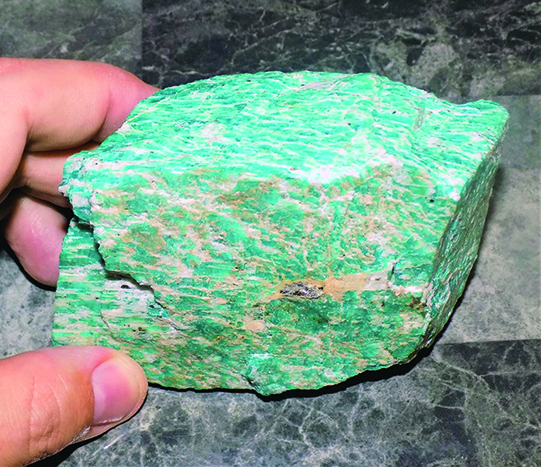
By Mark Leatherman
Like the elements of the Periodic Table, nearly all minerals derive their namesakes from words of many languages, people who discovered them, or possibly after the location of discovery. If one is new to the mineral amazonite, a common first guess is that it was initially identified in the Amazon rainforest of South America. As logical as this inference is, there has never been any amazonite reported from the namesake river region. A strong possibility is that early Spanish explorers confused amazonite with another similarly colored mineral they found in the area.
Still, it was an attractive stone to them, so much so the thought focused on use in costume jewelry. Despite this inference, the mineral is indeed found in Brazil but found significantly far from the famed river within the famous pegmatites in the state of Minas Gerais.
AMAZONITE’S ORIGINS
Amazonite is a legendary stone used by many early civilizations. The stone is believed and highly likely that it was the third stone in the breastplate of Moses. The ancient Egyptians prominently used the mineral for making amulets, as well as making beads. Such jewelry has even been found in King Tut’s tomb, as well as on the boy king’s golden mask. Also, The Judgment of Osiris, part of the fabled Book of the Dead, includes the mineral cut into slabs. To see amazonite used in ancient Egyptian jewelry, the Field Museum in Chicago has some pieces on display.
Traveling to the immediate south of the locality of origin, the Sudanese reportedly utilized the stone during Neolithic times for necklaces and other ornamentations commemorating the dead. In 2018, a geochemical and anthropological study published in the academic journal, Antiquity, revealed that Sudanese amazonite was originally sourced from southern Ethiopia to the southeast (more on this wonderful occurrence later!).
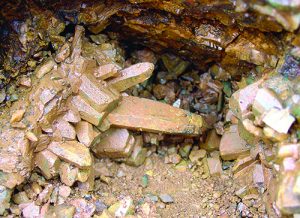
Lastly, the stone appeared in Assyrian civilization in connection with one of their chief gods, Belus. Oddly enough, the stone had seemingly dropped from all usage during medieval times. The stone received official recognition in 1701 with Nicolas Venette’s (1633-1698) Traite des Pierre (French for Treatise on Stones) dubbing it Pierre des Amazones (Stone of the Amazon). The name changed to amazonite in 1847, at the direction of Johann Breithaupt (1791-1873), after the later-disproven Amazon River locality.
I often like to draw an analogy connecting amazonite to aluminum, the latter being the raw metal and not atomic aluminum that the former indeed has. The raw aluminum metal was once much rarer than gold nuggets, due to its once-difficult nature of isolating the metal from its ores. With the onset of the Hall-Heroult process in 1886, the mass production of the metal made the value plummet. Despite its early associations with royalty and divinity, amazonite is presently a relatively inexpensive stone when used for modern “amulets” (cabochons), with the exceptional value based on perfect crystal forms and striking contrast with other associated minerals, which we’ll explore more about later.
The blue-green stone is a variety of the mineral microcline (KAlSi3O8), which is a member of the feldspar family, analogous to how amethyst is a purple variety of quartz. Microcline and orthoclase are polymorphs, meaning they carry the same chemistry but differ in their crystal structures. The specific feldspar that forms, usually found in igneous rocks, is fully dependent on temperature and cooling rates. In the case of microcline, it crystallizes from a rather slow cooling of a feldspar solid solution in magma. At low temperatures, the solid solution unmixes to form microcline intergrown with sodium-rich albite, often called perthitic texture. The white albite strikes through the microcline like small fingers, tentacles, or muscle fibers.
DEFINING COLOR
The coloration of microcline to amazonite was thought to have been caused by impurities of copper ions since the color of most copper compounds are as such. However, a Cal Tech study led by Anne Hofmeister and George Rossman in 1985 suggested that a combination of atomic water and lead impurities are responsible for amazonite’s striking hues. Even more amazing, research reveals that a richer color is directly related to increasing lead content, but only to a certain degree (a bell curve of sorts). Samples bearing some of the richest hues have been analyzed to contain around 1% PbO, but color richness can drop off if lead content increases.
Additionally, not just any form of lead will suffice for coloration. Trace radioactivity, from trace minerals concentrated in pegmatite pockets or host rock, can eliminate electrons in lead atoms. Lead in most minerals exists in the +2 ionic state. Radiation can convert this lead to the +3 state, the form that acts as the true chromophore. A more recent study, led by A. Szuzkiewicz and T. Korber in 2010, suggests some (not all) amazonites have their hues contributed by trace Fe+2 ions. Talk about a prized mineral that is like Goldilocks; nature must make it just right.
In exploring the similarities and differences that worldwide amazonite specimens offer, a great place to start would be the country from which the namesake originated. The renowned pegmatites of Brazil’s Minas Gerais is the source of the country’s most important amazonite specimens. Still, excellent specimen potential has recently been reported in the Vieiropolis Pegmatite field in the northeastern state of Paraiba. The bulk of the amazonite from this area is quarried by a company known as Granistone that supplies various types of granite. This massive amazonite is more correctly termed “amazonite granite.” The stone is intermixed with quartz, biotite, albite, and other accessory minerals, giving a somewhat-brecciated appearance.
Despite the lack of euhedral crystals, the sheer size of intact solid blocks that are commonly present in countertops and floors is still eye-catching. Both the Vieiropolis and the numerous Minas Gerais pegmatites formed as intrusions within metamorphic basement rocks. The former pegmatite bodies were emplaced during the Neoproterozoic (date ranges), and the latter swarm originated around 490 million years ago. Amazonite crystallizing within both pegmatite fields takes place simultaneously with quartz, mica, and albite. The gem-bearing pockets that have burgeoned record-keeping gems of topaz, quartz, tourmaline, and many others offer little in the way of euhedral amazonite specimens (though some exceptions do exist).
LEGENDARY LOCALITIES
Perhaps one of the best localities for “mass block specimens” of anhedral amazonite, while showing plenty of cleavage faces, are those that come from the Ilmensky Mountains (in the southern Urals) of Russia.
Historically, this locale was the richest and sole source for collectible amazonite
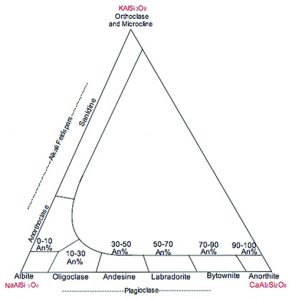
specimens. In 1920, Vladimir Lenin made the area into the Ilmen Nature Reserve, where visitors must apply to the nearby city of Miass to potentially visit (and it should go without saying that rockhounding is prohibited). The Ilmensky Mountains themselves are composed of over 70 rock types, representing from Precambrian to the Mesozoic period. There is also the possibility for pegmatites, carbonatites, nepheline syenites, and mafic-ultramafic bodies. The pegmatites alone are present in seven classes based on geometrical appearance, and main and accessory minerals.
The “amazonite pegmatites” category is the most famous of the seven classes, due to it attracting the mos research, as well as containing tabular amazonite veins made famous in the 1800s. Like the Brazilian pegmatites, scarce euhedral amazonites have been reported. Still, they are contrasted in their “pure vein” rather than “brecciated” appearance suggesting an area of separate crystallization from typical quartz, micas, and others (as in with “graphic granite”). Early Russian prospectors often looked for amazonite as a potential indicator to more valuable topaz. More details about the rock styles studied at the Ilmenskys are available in a proposal for the designation of the mountain as a UNESCO World Heritage Site. As of this publication, it has not been designated as such.
As an aside, I fondly remember seeing my first amazonite specimen as a sixth grader growing up in Ohio. My mother had taken me shopping at a mall in the town of Fairlawn, a suburb of Akron. Even at that age, I knew I wanted to be a scientist and enjoyed starting my small collection of tumbled stones. Thus, it was no surprise that when I saw a science discovery store, I insisted my mother take me inside. Prominently displayed on a shelf was a nice “brick” of Russian amazonite. I was so awestruck by its magnificent color that it did remind me of a rainforest.
Although my mother thought I was a little crazy when she saw me smelling the specimen, she bought it for me anyway. I kid you not that the scent somewhat-resembled a lush area after a good rain (technically called petrichor). Neither of us truly realized it then, but I’ve since known some geologists that can tell what a mineral is simply by the scent (other than sulfur)!
During a trip to the acclaimed Bancroft, Ontario rockhounding region, I had the opportunity to view my first amazonite in the field. It was May of 2005, and I was participating in my first university geology club trip, a week of being in Bancroft’s collecting heaven. One of our many enjoyable stops was “the beryl pit” (a.k.a. the Quadeville East Mine), now operated by a company called Aquarose. It was in this ‘beryl pit’ I logged my first field-collected amazonite. The specimen is a gradation or hybrid piece of pale green amazonite and “regular” salmon pink microcline (the lead chromophore was probably depleted during crystal growth), and it remains part of my collection. The amazonite-bearing pegmatites here present as dikes cutting through granitic gneisses that are around 1.28 billion years old.
From what I recall, there is a pit wall where microcline crystals are as big as a school bus (if only the said wall was pure amazonite). The “beryl pit” is one of the few localities where one can pay a fee to prospect the pit’s many pegmatite minerals, alongside amazonite. To purchase mine entry permits, one simply has to visit MacEwen Gas Station, in the small town of Quadeville.
A must-visit destination for East Coast amazonite enthusiasts, or any rockhound traveling to Virginia, is Morefield Mine. The mine was first discovered in 1929 by Silas Morefield. The surface was prospected for amazonite and micas and has turned into one of the few underground operations dedicated to the blue-green gem. If one is lucky enough to get a chance to venture underground, the massive blotches of amazonite seen on the tunnel walls are quite stunning! Unique specimens extracted from the mine show a combination with Mn-oxides, the pink iron-manganese phosphate mineral triplite, and topaz. Like with the “beryl pit,” the Morefield pegmatites are tabular dikes that cut across the gneissic country rock.
UNCOMMON CHARACTERISTICS
Another peculiarity of Morefield amazonite is its anomalously younger age than most other amazonite occurrences. Isotopic dating studies, involving rubidium-strontium and potassium-argon dating of feldspar and mica, yield a range of dates of 212 to 416 million years old; indicating a somewhat open and complex natural system. The ages are also unusual because natural radiation takes extensive geological time to alter the lead atoms to color the microcline. The vast majority of amazonite occurrences are Precambrian in age. As of this writing, tours in the Morefield Mine are suspended due to operations dedicated to further exploring and expanding the mine, but hopefully, a reopening is in the future. According to the mine’s Facebook page, one can still purchase bulk (per pound) amazonite.
The current champion is undoubtedly the Lake George region in Colorado when it comes to preeminent examples of both crystal forms and aesthetic contrast. The world-class amazonite-smoky quartz combinations were first discovered around the same time that Colorado achieved statehood in the 1870s. Gold miners prospected the region, along with mining companies, in pursuit of quartz and topaz. Although amazonite was an established mineral, such crystals were often discarded as “undesirables,” much like Montana sapphires were in the same pursuit of gold.
The “first gentleman of Colorado amazonite” was named Albert Whitmore, who prospected the region from the 1880s to the 1920s. He debuted the first spectacular finds during the 1893 World’s Fair in Chicago. It was not until the 1970s that newly discovered pockets showed amazonite in conjunction with smoky quartz, giving rise to some of the most attractive color-contrast mineral specimens the mineral collecting world saw. It was also during the 1970s that Joe Dorris staked his first Lake George area claims, culminating with acquiring the Smoky Hawk Claim that he and his family still operate today. I have had the great privilege of prospecting on his claim by participating in two rockhounding clubs, but I have yet to find the next honey hole. Numerous other claims in the area have been staked over the years resulting in an ongoing amazonite rush.
PIKES PEAK GRANITE CONNECTION
The geological story of Lake George amazonite starts with the one-billion-year-old Pikes Peak Granite, which, in turn, are intruded by multiple, slightly-younger intrusions. These younger granitic bodies created pegmatites that are more chemically-evolved (or fractionated) than those initially hosted in the main Pikes Peak granite. This slightly-different chemistry, along with pocket creation due to concentrated gases during the late stages of crystallization, gives rise to the famous amazonite and its cohorts (i.e., fluorite, topaz, and possible phenakite).
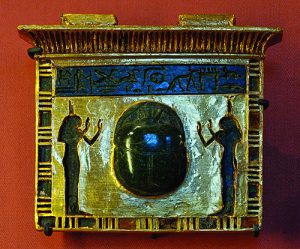
The Lake George area may seem like a treasure trove, but finding valuable pockets is still incredibly difficult. For one, pockets with great crystals always bear the possibility of collapse due to the potential movement of surrounding rock, thus breaking the specimens. Also, many pockets can be filled with sand or clay, further inhibiting discovery if one is not aware. According to Joe, less than three percent of all pockets discovered contains “jackpot” amazonite. Talk about hitting the geology lottery. Perhaps an even more rare lottery find is “white cap” specimens.
These tend to come about when the sides or terminations of crystals are pure microcline, and the lead chromophore has coincidentally run out. To add to the lure of the area is that amazonites, throughout the Pikes Peak region, the blue-green shade can differ across very localized areas, and even within the same claim. This is due to differing amounts of lead brought in by the more fractionated pegmatite melts, mentioned above, as the lead present in the Pikes Peak granite is not in concentrated enough quantities.
Although Colorado specimens are regarded by many to be the “champions,” remarkable specimens recently coming out of southern Ethiopia prove to be quite the worthy challenges. Specifically, Ethiopian specimens come from pegmatite mines just outside of the town of Konso. The source of these “new” specimens is the Kenticha pegmatite field, which is primarily a tantalum mine (and one of the most important in Africa to boot). Like Colorado specimens, Kenticha amazonites also display hue differences in various parts of the pegmatite field and occur alongside smoky quartz and albite, but lack fluorite. However, the exceptional crystals, varying color hues in a short distance, and mineralogical associations are the similarities between the two locales end.
The Kenticha field is dated to be 530 million years old, half the age of the Pikes Peak Granite. Whereas the Pikes Peak Granite is the large-scale host for slightly younger magma intrusions that have created amazonite-bearing pockets, the Kenticha pegmatites are products of melt generated from plate tectonic subduction. Additionally, the spectrum of blue-green hues found in the Ethiopian amazonites is owed to differing degrees of magmatic alterations, rather than different pulses of magma intruding the host granite with varying degrees of re-melting as seen with Pikes Peak.
For being part of the most common mineral group on Earth, the geological story of amazonite can get complicated rather quickly. As a rather common mineral at its core, amazonite surely brings some spice into any mineral collection in which great specimens can be had for all budgets.
I would like to personally thank Joe Dorris for his thoughtful reviews that have significantly improved this manuscript from its embryonic stages.
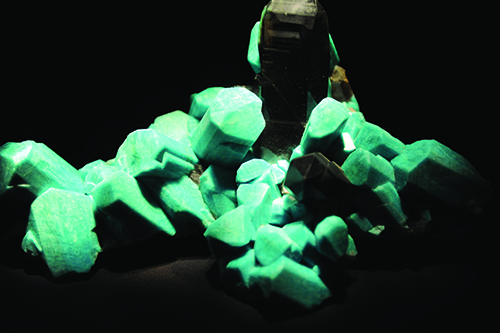
WIKIMEDIA COMMONS















